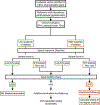DiscoVari: A Web-Based Precision Medicine Tool for Predicting Variant Pathogenicity in Cardiomyopathy- and Channelopathy-Associated Genes
- PMID: 37409478
- PMCID: PMC10527712
- DOI: 10.1161/CIRCGEN.122.003911
DiscoVari: A Web-Based Precision Medicine Tool for Predicting Variant Pathogenicity in Cardiomyopathy- and Channelopathy-Associated Genes
Abstract
Background: With genetic testing advancements, the burden of incidentally identified cardiac disease-associated gene variants is rising. These variants may carry a risk of sudden cardiac death, highlighting the need for accurate diagnostic interpretation. We sought to identify pathogenic hotspots in sudden cardiac death-associated genes using amino acid-level signal-to-noise (S:N) analysis and develop a web-based precision medicine tool, DiscoVari, to improve variant evaluation.
Methods: The minor allele frequency of putatively pathogenic variants was derived from cohort-based cardiomyopathy and channelopathy studies in the literature. We normalized disease-associated minor allele frequencies to rare variants in an ostensibly healthy population (Genome Aggregation Database) to calculate amino acid-level S:N. Amino acids with S:N above the gene-specific threshold were defined as hotspots. DiscoVari was built using JavaScript ES6 and using open-source JavaScript library ReactJS, web development framework Next.js, and JavaScript runtime NodeJS. We validated the ability of DiscoVari to identify pathogenic variants using variants from ClinVar and individuals clinically evaluated at the Duke University Hospitals with cardiac genetic testing.
Results: We developed DiscoVari as an internet-based tool for S:N-based variant hotspots. Upon validation, a higher proportion of ClinVar likely pathogenic/pathogenic variants localized to DiscoVari hotspots (43.1%) than likely benign/benign variants (17.8%; P<0.0001). Further, 75.3% of ClinVar variants reclassified to likely pathogenic/pathogenic were in hotspots, compared with 41.3% of those reclassified as variants of uncertain significance (P<0.0001) and 23.4% of those reclassified as likely benign/benign (P<0.0001). Of the clinical cohort variants, 73.1% of likely pathogenic/pathogenic were in hotspots, compared with 0.0% of likely benign/benign (P<0.01).
Conclusions: DiscoVari reliably identifies disease-susceptible amino acid residues to evaluate variants by searching amino acid-specific S:N ratios.
Keywords: channelopathy; exome sequencing; long QT syndrome; probability; syncope.
Conflict of interest statement
Figures





Similar articles
-
Pathogenicity Assignment of Variants in Genes Associated With Cardiac Channelopathies Evolve Toward Diagnostic Uncertainty.Circ Genom Precis Med. 2022 Jun;15(3):e003491. doi: 10.1161/CIRCGEN.121.003491. Epub 2022 May 11. Circ Genom Precis Med. 2022. PMID: 35543671
-
Identification of pathogenic variants in genes related to channelopathy and cardiomyopathy in Korean sudden cardiac arrest survivors.J Hum Genet. 2017 Jun;62(6):615-620. doi: 10.1038/jhg.2017.8. Epub 2017 Feb 16. J Hum Genet. 2017. PMID: 28202948
-
Exome Sequencing Highlights a Potential Role for Concealed Cardiomyopathies in Youthful Sudden Cardiac Death.Circ Genom Precis Med. 2022 Feb;15(1):e003497. doi: 10.1161/CIRCGEN.121.003497. Epub 2021 Dec 24. Circ Genom Precis Med. 2022. PMID: 34949102
-
Functional significance of channelopathy gene variants in unexplained death.Forensic Sci Med Pathol. 2019 Sep;15(3):437-444. doi: 10.1007/s12024-018-0063-y. Epub 2018 Dec 13. Forensic Sci Med Pathol. 2019. PMID: 30547356 Review.
-
Challenges of genetics in the diagnosis of sudden cardiac death. Interest for forensic and legal medicine.Med Clin (Barc). 2025 Feb 14;164(3):e1-e7. doi: 10.1016/j.medcli.2024.10.002. Epub 2024 Nov 18. Med Clin (Barc). 2025. PMID: 39562230 Review. English, Spanish.
Cited by
-
Dilated cardiomyopathy evaluation with Imagenomics: combining multimodal cardiovascular imaging and genetics.ESC Heart Fail. 2025 Aug;12(4):2669-2690. doi: 10.1002/ehf2.15307. Epub 2025 Apr 24. ESC Heart Fail. 2025. PMID: 40275589 Free PMC article. Review.
-
PidTools: Algorithm and web tools for crop pedigree identification analysis.Comput Struct Biotechnol J. 2024 Jul 5;23:2883-2891. doi: 10.1016/j.csbj.2024.07.004. eCollection 2024 Dec. Comput Struct Biotechnol J. 2024. PMID: 39108678 Free PMC article.
-
Diagnosis and management of dilated cardiomyopathy: a systematic review of clinical practice guidelines and recommendations.Eur Heart J Qual Care Clin Outcomes. 2025 Mar 3;11(2):206-222. doi: 10.1093/ehjqcco/qcae109. Eur Heart J Qual Care Clin Outcomes. 2025. PMID: 39674807 Free PMC article.
References
-
- Kurzlechner LM, Jones EG, Berkman AM, Tadros HJ, Rosenfeld JA, Yang Y, Tunuguntla H, Allen HD, Kim JJ, Landstrom AP. Signal-to-Noise Analysis Can Inform the Likelihood That Incidentally Identified Variants in Sarcomeric Genes Are Associated with Pediatric Cardiomyopathy. J Pers Med 2022;12. doi: 10.3390/jpm12050733 - DOI - PMC - PubMed
-
- Miller DT, Lee K, Chung WK, Gordon AS, Herman GE, Klein TE, Stewart DR, Amendola LM, Adelman K, Bale SJ, et al. ACMG SF v3.0 list for reporting of secondary findings in clinical exome and genome sequencing: a policy statement of the American College of Medical Genetics and Genomics (ACMG). Genet Med 2021;23:1381–1390. doi: 10.1038/s41436-021-01172-3 - DOI - PubMed
Publication types
MeSH terms
Substances
Grants and funding
LinkOut - more resources
Full Text Sources
Medical

